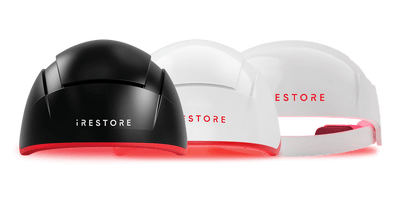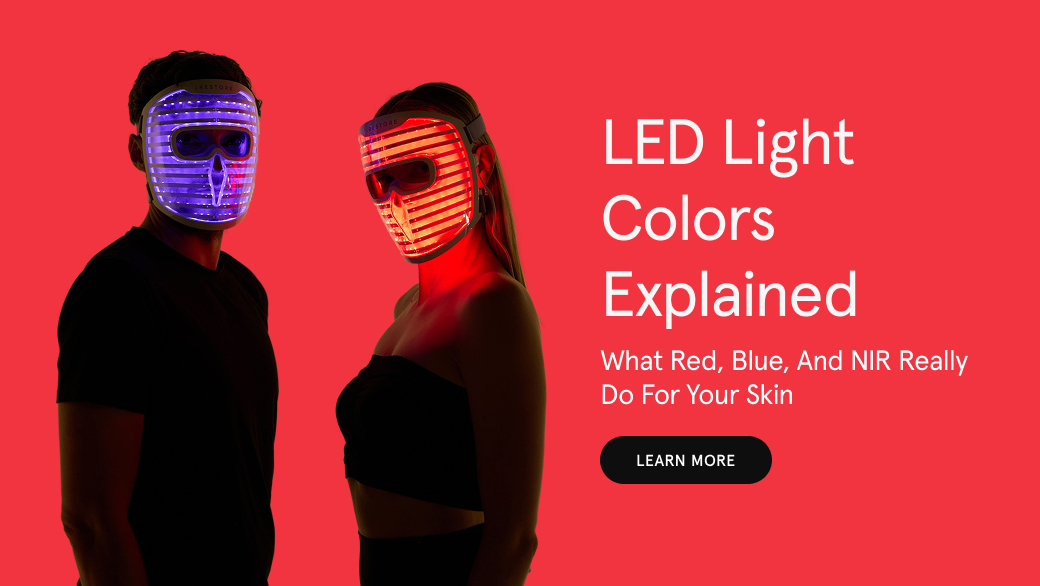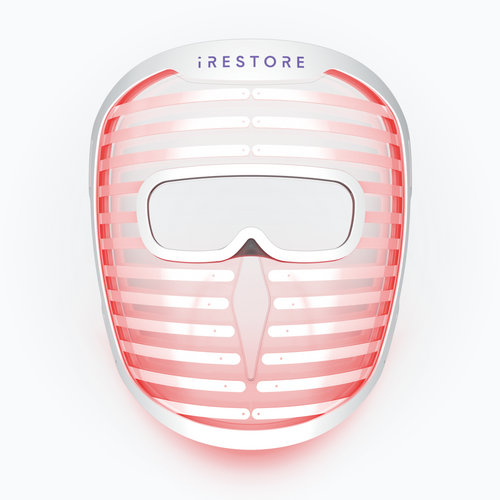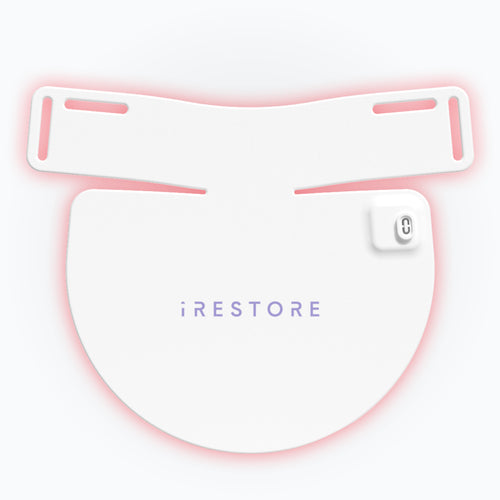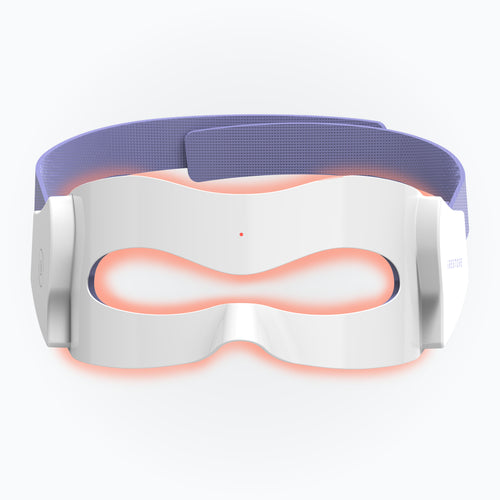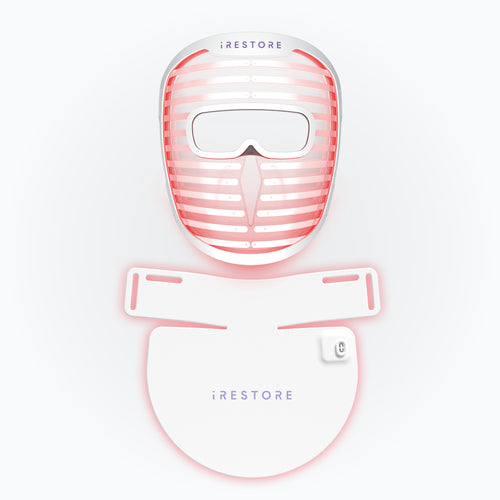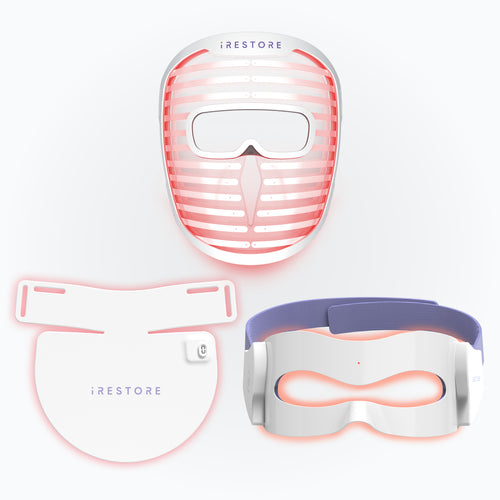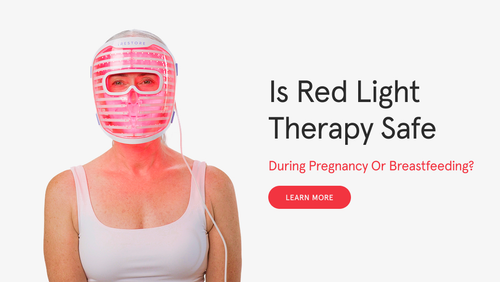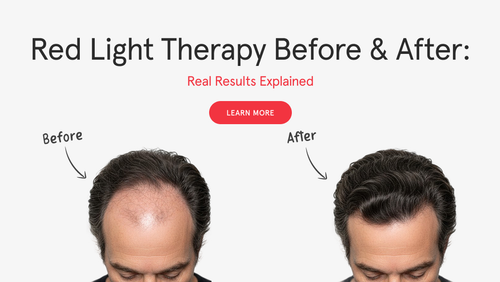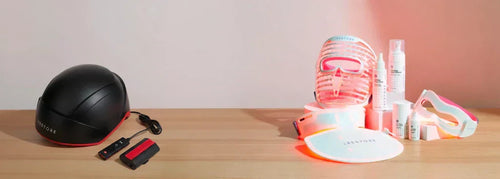Ever wondered what the colors on your LED mask actually do?
Red for wrinkles, blue for acne, near-infrared for healing, each color targets your skin in a different way.
LED light therapy works by using specific wavelengths of light to activate natural repair processes in your skin, similar to the way red light therapy helps reduce facial scars by stimulating regeneration. Knowing which LED light therapy colors address your goals helps you get real, visible results, not just glowing promises.
This article breaks down what red, blue, and NIR light really do, how they work beneath the surface, and how to choose the right color for your skin.
How LED Light Therapy Interacts with Your Skin
LED light therapy works through a process called photobiomodulation, the use of specific light wavelengths to trigger biological changes in your skin cells.
When light energy reaches the skin, chromophores (light-sensitive molecules inside cells) absorb it. This absorbed energy stimulates the mitochondria, often called the cell’s power source, to produce more adenosine triphosphate (ATP), the molecule responsible for cellular energy.
With more energy, skin cells perform their functions better:
-
Fibroblasts create more collagen and elastin (for firmness and elasticity).
-
Keratinocytes repair the skin barrier faster.
-
Circulation improves, bringing oxygen and nutrients to the skin’s surface.
Unlike UV light, LED light is non-ionizing, meaning it doesn’t damage DNA or cause burns, making it safe for home use in skin rejuvenation treatments. Instead, it enhances the skin’s ability to repair, rejuvenate, and balance itself naturally.
That’s why LED therapy has become a dermatologist-approved method for addressing aging, acne, and inflammation, using light, not heat or chemicals.
What Different LED Light Therapy Colors Mean
Every color of LED light represents a different wavelength and each wavelength interacts with your skin at a specific depth.
This is why LED light therapy colors deliver such distinct results: blue targets surface bacteria, red works deeper on collagen, and near-infrared (NIR) reaches the tissue beneath.
Light within the visible and near-infrared spectrum (400–850 nanometers) can influence everything from acne reduction to cellular repair. The deeper the light penetrates, the more it affects long-term skin rejuvenation rather than surface-level concerns.
Here’s a quick breakdown of the most studied colors and their benefits:
|
Color |
Wavelength Range (nm) |
Skin Depth |
Main Function |
|
Blue Light |
415–450 nm |
Epidermis (outer layer) |
Kills acne-causing bacteria and balances oil production |
|
Red Light |
630–660 nm |
Dermis (middle layer) |
Stimulates collagen, improves tone, reduces wrinkles |
|
Near-Infrared (NIR) |
800–850 nm |
Deep tissue |
Reduces inflammation, accelerates healing, improves circulation |
These LED light therapy colors can be used alone or in combination, depending on your skin goals. For instance, red and NIR are often paired for anti-aging and recovery, while blue and red work together for acne treatment and healing support.
Understanding how wavelength affects skin response helps you choose the right light color for your skin’s unique needs, rather than relying on generic recommendations.
-
Red Light Therapy
If your main skincare goals are reducing fine lines, improving firmness, or restoring a healthy glow, red light therapy is the wavelength to know.
How it works: Red light (around 630–660 nanometers) penetrates into the dermis, where it stimulates fibroblast cells, the ones responsible for producing collagen and elastin. This process, known as photobiomodulation, boosts the skin’s ability to repair itself from within.
Over time, consistent exposure to red light helps:
-
Increase collagen density, leading to smoother, firmer skin.
-
Reduce fine lines and wrinkles by improving elasticity.
-
Even out skin tone by reducing redness and inflammation.
-
Accelerate wound healing, making it beneficial after cosmetic procedures.
Several clinical studies support these effects. For example, research published in Photomedicine and Laser Surgery found that red light therapy significantly improved skin texture and collagen production after 12 weeks of use.
Best for:
-
Mature or aging skin
-
Redness-prone or post-procedure skin
-
Anyone seeking non-invasive rejuvenation
Pro tip: Use red light consistently 3–5 times a week for optimal results, short, frequent sessions work better than occasional long treatments.
-
Blue Light Therapy
If breakouts are your biggest skin concern, blue light therapy targets the problem at its source, the bacteria responsible for acne.
How it works: Blue light, typically in the 415–450 nanometer range, penetrates the upper layer of your skin (epidermis) and reaches Cutibacterium acnes (formerly Propionibacterium acnes), the bacteria that trigger inflammation and clogged pores. When these bacteria absorb blue light, a chemical reaction releases oxygen radicals that destroy them, reducing both acne and future flare-ups.
Key benefits of blue light therapy:
-
Kills acne-causing bacteria without damaging healthy skin.
-
Reduces excess sebum production, helping prevent new pimples.
-
Calms inflammation and redness linked to breakouts.
-
Improves skin clarity over consistent use.
Clinical studies and dermatologists confirm that blue LED therapy is FDA-cleared for mild to moderate acne. It’s gentler than topical acids and safe for most skin types when used correctly.
Best for:
-
Oily or acne-prone skin
-
Teen and adult acne management
-
Red, inflamed breakouts
Usage tip: For balanced results, many users pair blue light (to clear acne) with red light (to heal and reduce scarring). Cleanse your skin first, avoid applying strong actives like retinoids immediately before treatment, and follow your device’s timing guidelines for safety.
-
Near-Infrared (NIR) Light: The Deep Healer
You can’t see near-infrared (NIR) light, but your skin and body respond to it in powerful ways.
While red and blue lights target surface concerns, NIR light (usually between 800 and 850 nanometers) penetrates deep into the sub-dermal layers, reaching muscles, connective tissue, and even blood vessels.
How it works: NIR wavelengths activate cellular metabolism at a deeper level through photobiomodulation, enhancing ATP production, increasing microcirculation, and reducing oxidative stress in tissue. This makes NIR one of the most effective tools for long-term healing and recovery.
Key benefits of near-infrared light therapy:
-
Reduces inflammation and post-treatment swelling.
-
Improves blood flow, delivering oxygen and nutrients to damaged skin.
-
Accelerates recovery after laser, microneedling, or cosmetic procedures.
-
Relieves muscle tension and joint discomfort, supporting holistic skin wellness.
-
Enhances skin repair, promoting smoother texture and resilience.
Clinical research in Lasers in Medical Science shows that NIR light stimulates deep-tissue regeneration and can even improve circulation in photoaged or stressed skin.
Best for:
-
Sensitive or inflamed skin
-
Post-procedure recovery
-
Users seeking both cosmetic and wellness benefits
Pro tip: Pair red and NIR light in alternating or combined sessions, red light supports visible rejuvenation, while NIR handles deeper repair, making the duo ideal for full-spectrum skin health.
How to Choose the Right LED Light Color for Your Skin Goals
Choosing the right LED light therapy color depends on your skin’s current needs, not just the device you own. Each wavelength affects specific biological processes, so matching the right color to your concern ensures better results and fewer side effects.
Here’s a simple, research-backed way to decide:
|
Skin Concern |
Recommended LED Light Color |
Why It Works |
|
Fine lines, wrinkles, loss of elasticity |
Red Light (630–660 nm) |
Stimulates collagen and elastin, improving firmness and texture |
|
Acne and oily skin |
Blue Light (415–450 nm) |
Kills acne-causing bacteria, reduces inflammation and sebum |
|
Redness, sensitivity, post-treatment recovery |
Near-Infrared (800–850 nm) |
Calms inflammation and promotes deeper healing |
|
Uneven tone or dullness |
Red + NIR Combo |
Boosts circulation and accelerates cell renewal |
|
Breakouts and healing |
Blue + Red Combo |
Combats acne while repairing and soothing skin |
When used consistently, LED light therapy colors can help your skin maintain balance, resilience, and radiance without invasive treatments.
What Real Users Are Saying About iRESTORE LED Light Therapy
When it comes to skincare devices, trust comes from real results and not just lab data.
That’s why user experiences with the iRESTORE LED light therapy mask matter so much. Across hundreds of reviews, users consistently mention three things: comfort, visible improvement in just a few weeks, and ease of staying consistent with daily use.
Here’s what verified users had to say:
⭐⭐⭐⭐⭐ “Amazing Results In Just A Few Weeks!”
“I’ve been using the iRESTORE LED light therapy mask for just a few weeks, and I’m already seeing a marked difference in the lines around my eyes. My rosacea has improved significantly, and even the dark spots on my face have lightened. I love how comfortable it is to wear — unlike other LED masks, this one stays securely in place. Ten minutes a day is all it takes, and I can multitask while using it.”

⭐⭐⭐⭐⭐ “Wish I Bought This One First”
“I’ve been using this LED mask for four weeks now, and I love it! The wrinkles around my eyes and jowls are so much less noticeable. It’s lightweight, comfortable, and doesn’t shift when I move around. My old mask took 30 minutes and was hard to wear — this one only takes 10 minutes a day and gives me better results.”

Best Practices for LED Light Therapy
To get the most out of LED light therapy while keeping your skin safe, follow these best practices:
-
Start with clean, dry skin to ensure maximum light absorption.
-
Follow your device’s recommended settings for duration and frequency — usually 10–20 minutes, three to five times a week.
-
Avoid using harsh skincare actives like retinoids, AHAs, or BHAs right before a session.
-
Use protective eyewear when using bright or multi-colored LED devices, especially those with blue light as also advised in our guide on red light therapy face masks and eye safety.
-
Stay consistent. Short, regular sessions are more effective than long, occasional ones.
-
Moisturize afterward to support skin hydration and enhance post-treatment glow.
-
Store your device safely away from water or direct sunlight to maintain longevity.
Consistency and proper use are key, LED light therapy works gradually by supporting your skin’s natural renewal process, leading to visible and lasting improvements over time.
Conclusion
Each LED light color plays a distinct role in how your skin looks and feels, red for collagen and firmness, blue for acne and clarity, and near-infrared for deep healing and repair.
When you understand what these colors do, you can personalize your routine instead of guessing what your skin needs.
The real benefit of LED light therapy isn’t just visible improvement, it’s control. It lets you treat your skin intelligently, using technology that works with your biology, not against it.
If you’re ready to bring professional-grade results home, try the iRESTORE Illumina LED Face Mask, designed with clinically proven wavelengths that make it easy to experience the science of better skin, every day.
FAQs About LED Light Therapy Colors
Is LED light therapy safe for all skin types?
Yes. LED light therapy is non-invasive and non-thermal, meaning it doesn’t cause burns or damage DNA. It’s suitable for most skin types, including sensitive and mature skin, when used as directed. If you’re on medication that increases light sensitivity, consult your dermatologist before use.
Can I use red and blue LED light at the same time?
Yes. Combining red and blue light is often recommended for acne-prone skin, blue light clears bacteria while red light reduces inflammation and supports healing. Many advanced LED masks include multi-color modes to deliver these wavelengths simultaneously or sequentially.
How long does it take to see results from LED light therapy?
Most users notice visible changes within 4–6 weeks of consistent use. Results depend on the wavelength, session frequency, and your skin’s natural regeneration cycle. The key is regular, short sessions rather than long, infrequent ones.
How often should I use LED light therapy at home?
For best results, use your LED light therapy device 3–5 times per week for 10–20 minutes per session. Consistency is more important than duration, gradual exposure helps cells function better and sustain results over time.
Disclaimer: The iRESTORE blog is for informational purposes only and is not intended to replace professional medical advice or treatment. Please do not ignore professional guidance because of information you’ve read here. If you have concerns about your hair or skin health, we encourage you to consult a qualified healthcare professional.
